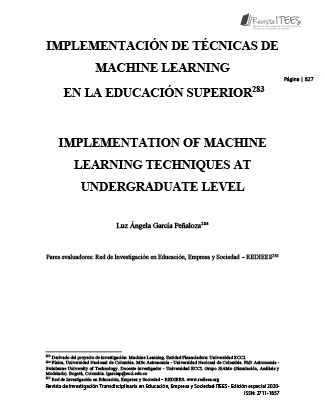XLIII. IMPLEMENTACIÓN DE TÉCNICAS DE MACHINE LEARNING EN LA EDUCACIÓN SUPERIOR
##plugins.themes.bootstrap3.article.main##
Resumen
La coyuntura global causada por el COVID-19 nos ha llevado a repensar nuestros métodos
de enseñanza. La educación superior no es ajena a esa transformación, y a consecuencia, los
docentes e investigadores hemos implementado nuevas técnicas y metodologías en nuestros
proyectos. En el campo de la astronomía toman cada día más fuerza los algoritmos de
Machine Learning por su versatilidad y alto poder de predicción, que resulta de la puesta en
marcha de estas técnicas a grandes conjuntos de datos. Existen varios proyectos que he
implementado con mis estudiantes: el primero explora la potencialidad de las redes
neuronales para mejorar la estimación de algunos parámetros cosmológicos del modelo
estándar ΛCDM. El segundo utiliza un algoritmo no supervisado de K-means para clasificar
cuásares (objetos muy luminosos y distantes), a partir de diferentes propiedades físicas
observadas por el SDSS (Sloan Digital Sky Survey) en las campañas 12 y 14. A partir de los
espectros de poderosos agujeros negros a grandes corrimientos al rojo, y otras propiedades
físicas detectadas por el Sloan, generamos una clasificación de cuásares que presentan ciertas
líneas de absorción.
El objetivo fundamental de este trabajo es mostrar el impacto que tiene la implementación
de modernas técnicas de Machine Learning en proyectos de investigación con estudiantes de
Ingeniería y las perspectivas de estos proyectos en otras disciplinas.
Download Statistics
##plugins.themes.bootstrap3.article.details##
aprendizaje de máquinas, aprendizaje profundo, educación superior, redes neuronales.
https://openai.com/blog/ai-and-compute/. 2019.
M. Ntampaka, C. Avestru, et al. Astro2020 Science White Paper: The Role of Machine
Learning in the Next Decade of Cosmology, arXiv:1902.10159v1
S. Dodelson. Modern Cosmology, Academic Press, Elsevier Science, 2003
S. Ravanbakhs, J. Oliva, et al. Estimating Cosmological Parameters from the Dark Matter
Distribution, arXiv:1711.02033v1
S. Pan, M. Liu, et al. Cosmological Parameter Estimation From Large-scale Structure Deep
Learning, Aceptado en ApJ. arXiv:1908.10590v4
J. H. T. Yip, X. Zhang, et al. From Dark Matter to Galaxies with Convolutional Neural
Networks, Second Workshop on Machine Learning and the Physical Sciences
(NeurIPS 2019), arXiv:1910.07813v1.
Siyu He, Y. Li, et al. “Learning to Predict the Cosmological Structure Formation”, PNAS,
vol. 116, 28, 1–8, 2019.
J. Zamudio-Fernandez, A. Okan, et al. Higan: Cosmic Neutral Hydrogen With Generative
Adversarial Networks, arXiv:1904.12846v1.
E. Giusarma, M. R. Hurtado, et al. “Learning Neutrino Effects Cosmology With
Convolutional Neural Networks”, arXiv:1910.04255v1.
Z. Guo, P. Martini. Classification of Broad Absorption Line Quasars with a Convolutional
Neural Network. The Astrophysical Journal, vol 879, issue 2, 72, 12, 2019.
S. Skillman, M. Warren, M. Turk, et al. Dark Sky Simulations: Early Data Release.
arXiv:1407.2600.
M. S. Warren. 2HOT: An Improved Parallel Hashed Oct-Tree N-Body Algorithm for
Cosmological Simulation. arXiv:1310.4502.
L. A. García, E. Tescari, et al. Theoretical study of an LAE – CIV absorption pair at z = 5.7,
Monthly Notices of the Royal Astronomical Society: Letters, vol. 469, issue 1, pp.
L53-L57, 2017.
L. A. García, E. Tescari, et al. Simulated metal and HI absorption lines at the conclusion of
Reionization, Monthly Notices of the Royal Astronomical Society, vol. 470, issue 2,
pp. 2494-2509, 2017.
L. A. García, E. V. Ryan-Weber. Can UVB variations reconcile simulated quasar absorption
lines at high redshift? Revista Mexicana de Astronomía y Astrofísica, vol. 56, pp. 97-
111, 2020.
P. A. R. Ade et al. Planck 2015 results. XIII. Cosmological parameters, arXiv:1502.01589.
N. Aghanim et al. Planck 2018 results. VI. Cosmological parameters, arXiv:1807.06209.
Y. LeCun, L.D. Jackel, B. Boser, et al. Handwritten Digit Recognition: Applications of
Neural Net Chips and Automatic Learning. IEEE Communication, pp. 41-46, 1989.
D. E. Rumelhart, G. E. Hinton, J. L. McClelland. A general framework for parallel distributed
processing. vol 1: Foundations pp. 45–76, 1986.
L. Deng, D. Yu. Deep Learning: Methods and Applications. NOW Publishers, 2014.
I. Goodfellow, Y. Bengio, A. Courville. Deep Learning. MIT Press,
http://www.deeplearningbook.org, 2016.
D. Osinga. Deep Learning Cookbook: Practical Recipes to Get Started Quickly. O'Reilly
Media, Inc., 2018.
H. Fathivavsari. Deep Learning Prediction of Quasars Broad Ly alpha Emission Line.
arXiv:2006.05124v1
V. de Sainte Agathe, C. Balland, Hélion et al. Baryon acoustic oscillations at z = 2.34 from
the correlations of Ly alpha absorption in eBOSS DR14. Astronomy & Astrophysics,
629, A85, 2019





